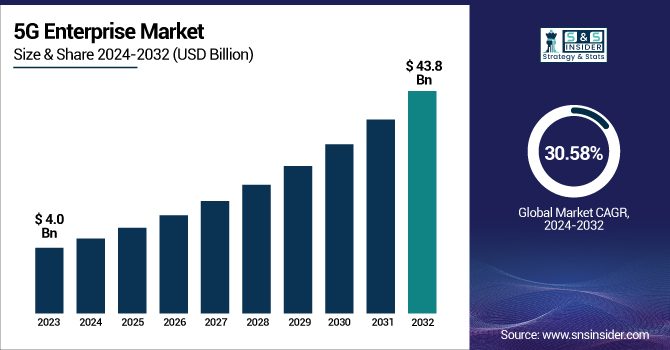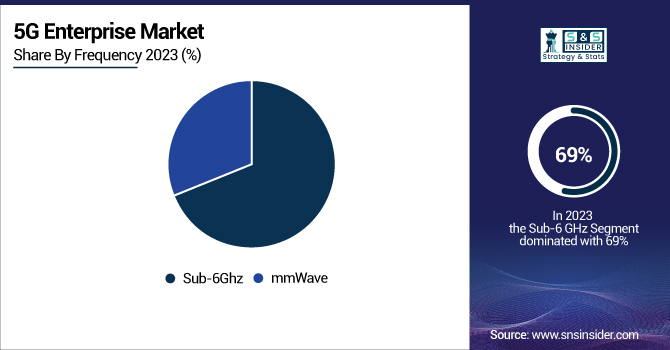5G Enterprise Market Report Scope & Overview:
The 5G Enterprise Market was valued at USD 4.0 billion in 2023 and is expected to reach USD 43.8 billion by 2032, growing at a CAGR of 30.58% from 2024-2032.

To Get more information on 5G Enterprise Market - Request Free Sample Report
This report consists of key statistical insights into the 5G Enterprise Market, highlighting its rapid expansion. The adoption of 5G in enterprises is accelerating across industries such as manufacturing, healthcare, and retail, driving automation and connectivity advancements. Private 5G network deployments vary by region, with significant investments in dedicated networks ensuring secure and high-performance enterprise operations. The market is also witnessing substantial growth in 5G-enabled IoT devices, revolutionizing applications in smart factories, autonomous logistics, and remote monitoring. Enterprise spending on 5G infrastructure differs by region, influenced by regulatory environments and business priorities. In this report, we observe a rising focus on AI-driven network optimization and increasing collaborations between telecom providers and enterprises to develop customized 5G solutions.
The 5G Enterprise Market in the U.S. was valued at USD 1.2 billion in 2023 and is expected to reach USD 16.4 billion by 2032, growing at a CAGR of 30.37% from 2024-2032, driven by rising demand for ultra-reliable low-latency communication (URLLC), increasing private 5G network deployments, and enterprise digital transformation. Expanding use cases in smart manufacturing, healthcare, and autonomous systems are accelerating market growth. The market is expected to witness steady expansion through 2030, fueled by AI-driven network optimization and strong government support for 5G infrastructure.
5G Enterprise Market Dynamics
Drivers
-
Enterprises require 5G for real-time data transmission, automation, and IoT-driven operations, accelerating market growth.
The demand for ultra-reliable low-latency communication is fuelling enterprise 5G. 5g enables accurate time data transmission, seamless automation, and even remote monitoring, which is something manufacturing, healthcare, and smart cities across the world require. Moreover, Industry 4.0 growth and IoT-based solutions have propelled the demand for high speed and reliable connectivity. The Progression to 5G Networks for Businesses As businesses increasingly transition to cloud computing and artificial intelligence applications, 5G networks will effectively underpin that progress. The U.S. market is the one that has been investing heavily in private networks running on 5G, which is providing enterprises with better operations in an environment that helps improve security, efficiency, and productivity.
Restraints
-
The high cost of 5G infrastructure, network densification, and integration complexities hinder widespread enterprise adoption.
The deployment of 5G enterprise networks will require significant investments in infrastructure, spectrum, and network deployment. The high capital outlay for moving to 5G, as well as the complexity of 5G integration in existing IT infrastructure, has caused concern for enterprises, especially small- and medium-sized ones. Another one is network densification (Installing lots of small cells), which is expensive. This is further compounded by regulatory approvals and zoning restrictions for new infrastructure deployment for 5G, making it near-impossible for enterprises to leverage and realise the full set of benefits from 5G in the near term.
Opportunities
-
Private 5G networks offer secure, high-performance connectivity, driving adoption in industries like logistics, energy, and defense.
Deployment of private 5G networks has also become a big growth opportunity, as these enable enterprises to build their own secure, high-throughput networks to address their operational needs. Other industries, such as logistics, energy, and defense, are investing in private 5G for better automation, safety, and data security. Such networks provide more control over data traffic, increased reliability, and less reliance on public carriers. Moreover, AI and edge computing combined with private 5G is facilitating better decisions and enhanced efficiencies. With telecom providers and technology providers working together to provide custom 5G solutions, this segment is expected to see significant growth.
Challenges
-
The increasing reliance on 5G for critical applications raises cybersecurity risks, requiring robust security measures and regulatory compliance.
With enterprises increasingly relying on 5G for mission-critical applications, cybersecurity threats and data privacy concerns are becoming major challenges. The massive volume of data transmitted over 5G networks creates new vulnerabilities, making networks susceptible to cyberattacks. Enterprises must implement robust security protocols, including encryption and AI-powered threat detection, to mitigate risks. Additionally, compliance with data protection regulations varies by region, adding complexity to enterprise 5G deployments. Addressing these security challenges is crucial for ensuring widespread adoption and trust in 5G enterprise solutions.
5G Enterprise Market Segmentation Analysis
By Spectrum
In 2023, the Licensed Spectrum segment dominated the market and accounted for significant revenue share due to its reliability, security, and interference-free connectivity that it offers. Licensed spectrum remains the preferred choice, especially as the enterprise identifies new critical applications such as industrial automation, telemedicine, and smart infrastructure, where continuous communications with low latency are required. And it is backed by telecom giants that are pouring billions into licensed 5G networks.
The Shared Spectrum segment is expected to register the fastest compound annual growth rate, owing to increasing enterprise focus on cost-effective and flexible 5G deployments. This enables businesses to access 5G connectivity without the need to purchase expensive exclusive spectrum licenses, and it’s particularly well-suited to small- and medium-sized enterprises and private network deployments. The rise of CBRS and dynamic spectrum sharing technology is also driving growth.
By Frequency
The Sub-6 GHz dominated the market and accounted for 69% of revenue share due to better coverage and reliability. This frequency band is also used by enterprises to deliver wide-area connectivity across their footprints—on campus, in manufacturing facilities, and in logistics hubs. Moreover, the telecom operator's extensive deployment with Sub-6 GHz also helped it solidify its market leadership.
The mmWave segment is anticipated to have the fastest CAGR owing to the growing demand for ultra-high-speed, low-latency connectivity services in enterprise applications. Mastering mmWave will be essential for smart factories, autonomous vehicles, and household appliances, as well as AR/VR enterprise solutions. Its range limitations complicate deployment, but ongoing improvements in network densification and small cell technology are accelerating adoption.

By Organization Size
In 2023, the Large Enterprises segment dominated the market and accounted for 75% of revenue share. 5G-enabled technologies drive significant demand in the market from large companies in manufacturing, healthcare, and finance for automation, IoT integration, and AI-driven analytics. Their leadership is complemented by a strong IT infrastructure and telecom provider partnerships.
The Small and Medium-Sized Enterprises segment is anticipated to register the fastest CAGR due to the growing affordability of 5G solutions and the introduction of the shared spectrum model. Both private 5G networks and cloud-based solutions are now being rapidly adopted by SMEs to increase productivity, streamline supply chains, and create better experiences for their customers. Adoption is also being further spurred by government incentives and telecom partnerships offering scalable 5G solutions.
By Vertical
The Manufacturing Segment dominated the market and accounted for a significant revenue share in 2023, owing to the rapid acceptance of Industry 4.0, Automation, and IoT-driven smart factories. 5G enables real-time monitoring, predictive maintenance, and robotics for manufacturers, improving operational efficiency and reducing downtime. The adoption of private 5G networks is only bolstering due to the requirement of ultra-reliable low-latency communication.
The Healthcare segment is projected to deliver a rapid CAGR, owing to the growing demand for telemedicine, remote patient monitoring, and AI-powered diagnostics. For critical applications such as robotic surgeries, smart hospitals, and connected medical devices, real-time data transmission is possible thanks to 5G. It helps avail better results for patients. This market growth was bolstered by an acceleration toward digitised healthcare solutions that the COVID-19 pandemic spearheaded.
Regional Landscape
North America dominated the market and accounted for the largest share of the 5G Enterprise Market due to early 5G deployment, strong telecom infrastructure, and wide enterprise adoption in multiple sectors such as manufacturing, healthcare, and retail. The U.S. heads the region in substantial investments in private 5G networks and relationships between telecom providers and enterprises. Moreover, government initiatives to promote the allocation of spectrum and develop smart cities also boost the growth of the market.
The Asia Pacific is projected to achieve the fastest CAGR on account of swift 5G development in nations like China, Japan, South Korea, and India. High government support, rising demand for smart factories, and growing Industry 4.0 presence will drive the market growth in the coming term. Last-mile connectivity is happening at the same time: Firms in industries such as manufacturing, logistics, and healthcare are fast-tracking 5G use for automation and IoT integration.

Get Customized Report as per Your Business Requirement - Enquiry Now
Key Players
The major key players along with their products are
-
Ericsson – Ericsson Private 5G
-
Nokia – Nokia Digital Automation Cloud (DAC)
-
Huawei – Huawei 5G Core
-
Samsung – Samsung 5G vRAN
-
Cisco – Cisco Ultra-Reliable Wireless Backhaul
-
Qualcomm – Qualcomm 5G RAN Platforms
-
ZTE Corporation – ZTE 5G Integrated Solution
-
Verizon – Verizon Business 5G Edge
-
AT&T – AT&T 5G for Business
-
T-Mobile – T-Mobile 5G Advanced Network Solutions
-
Deutsche Telekom – Campus Network Private 5G
-
NEC Corporation – NEC 5G Open vRAN
-
Intel – Intel Xeon Scalable Processors for 5G
-
IBM – IBM Cloud Satellite with 5G
-
Hewlett Packard Enterprise (HPE) – HPE 5G Core Stack
Recent Developments
-
December 2024 – Ericsson: Secured a multi-year extension deal worth billions with Bharti Airtel to provide 4G and 5G radio access network products and solutions, highlighting the growing demand for advanced telecommunications infrastructure amid the industry's transition to 5G technologies.
-
December 2024 – Vodafone UK and Three UK: Received approval from the UK's Competition and Markets Authority for their £16.5 billion merger, contingent upon commitments to invest in 5G network development and implement customer protections.
-
February 2025 – Nokia and AT&T: Entered a multi-year agreement to enhance AT&T's voice carriage and 5G network automation, integrating AI and machine learning capabilities into the network.
-
January 2025 – Telefónica: Achieved over 90% 5G coverage in Spain and implemented 'Network Slicing' technology across various sectors, including industrial, healthcare, and emergency services, enhancing connectivity and response capabilities.
|
Report Attributes |
Details |
|
Market Size in 2023 |
US$ 4.0 Billion |
|
Market Size by 2032 |
US$ 43.8 Billion |
|
CAGR |
CAGR of 30.58 % From 2024 to 2032 |
|
Base Year |
2023 |
|
Forecast Period |
2024-2032 |
|
Historical Data |
2020-2022 |
|
Report Scope & Coverage |
Market Size, Segments Analysis, Competitive Landscape, Regional Analysis, DROC & SWOT Analysis, Forecast Outlook |
|
Key Segments |
• By Spectrum ( Licensed, Unlicensed, Shared.) |
|
Regional Analysis/Coverage |
North America (US, Canada, Mexico), Europe (Eastern Europe [Poland, Romania, Hungary, Turkey, Rest of Eastern Europe] Western Europe] Germany, France, UK, Italy, Spain, Netherlands, Switzerland, Austria, Rest of Western Europe]), Asia Pacific (China, India, Japan, South Korea, Vietnam, Singapore, Australia, Rest of Asia Pacific), Middle East & Africa (Middle East [UAE, Egypt, Saudi Arabia, Qatar, Rest of Middle East], Africa [Nigeria, South Africa, Rest of Africa], Latin America (Brazil, Argentina, Colombia, Rest of Latin America) |
|
Company Profiles |
Ericsson, Nokia, Huawei, Samsung, Cisco, Qualcomm, ZTE Corporation, Verizon, AT&T, T-Mobile, Deutsche Telekom, NEC Corporation, Intel, IBM, Hewlett Packard Enterprise (HPE). |

